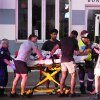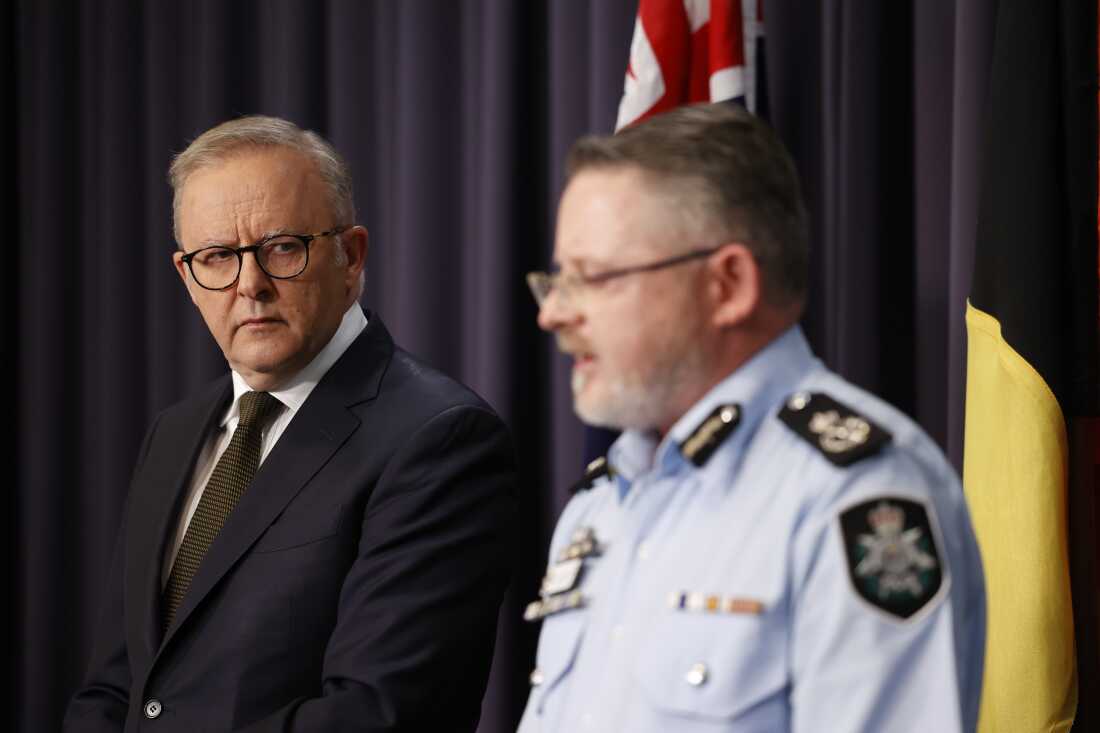News
Jimmy Carter’s body set to be transferred today to Washington, D.C., for state funeral

Former President Jimmy Carter‘s casket is being transferred Tuesday to Washington, D.C., for the next phase of his state funeral.
Carter has been lying in repose in Atlanta, as part of six days of observances that began Saturday with a service at his boyhood home in Plains, Georgia.
“This is somebody from a small town in south Georgia who was a peanut farmer who ultimately became the president of the United States,” said Carter’s grandson, Jason Carter, at the Plains service on Saturday. “It’s a pretty remarkable American story.”
Carter, the 39th president, died on Dec. 29 at the age of 100 — living longer than any president in U.S. history. His beloved wife of 77 years, Rosalynn, died in November 2023.
On Tuesday, Carter’s body will be flown from Atlanta to Joint Base Andrews in Maryland, where his casket will be transferred with ceremony to a hearse. From there, a motorcade will proceed to the U.S. Navy Memorial, where his casket will then be transferred from a hearse to a horse-drawn caisson with ceremony.
The caisson will travel to the U.S. Capitol, where Carter’s casket will be carried up the stairs into the Rotunda by military body bearers. Members of Congress will be able to pay their respects during a service.
Beginning Tuesday afternoon, Carter will lie in state in the Capitol Rotunda until Thursday, when his funeral service will be held at the National Cathedral before his remains are flown back to Georgia. President Biden is will be delivering a eulogy at Thursday’s service, along with several others. President-elect Donald Trump said he will attend.
There will be a final private service in Plains, and Carter will be buried next to Rosalynn Carter at his family’s peanut farm.
Full schedule of Tuesday’s events (all times Eastern):
- 9:30 a.m.: A departure ceremony from the Carter Presidential Center.
- 10 a.m.: The motorcade departs for Dobbins Air Reserve Base, Georgia.
- 10:40 a.m.: The late president and his family arrive at Dobbins Air Reserve Base and board Special Air Mission 39 after an arrival ceremony.
- 11:15 a.m.: Special Air Mission 39 departs for Washington.
- 12:45 p.m.: Special Air Mission 39 arrives at Joint Base Andrews, Maryland, and Carter’s remains are transferred with ceremony to the hearse.
- 1:15 p.m.: The motorcade departs for the U.S. Navy Memorial.
- 2 p.m.: The motorcade arrives at the U.S. Navy Memorial and Carter’s remains are transferred from a hearse to a horse drawn caisson with ceremony.
- 2:15 p.m.: The funeral procession begins marching up to the U.S. Capitol via Pennsylvania Avenue, turning left onto Constitution Avenue.
- 2:40 p.m.: Upon arrival at the U.S. Capitol, the late president is carried up the stairs by military body bearers and into the Rotunda.
- 3 p.m.: Congress pays their respects during a service in the Rotunda.
- 3:45 p.m.: Carter begins lying in state while the military maintains a guard of honor.
- 7 p.m. to midnight: Lying in state opens to the public.

News
Video: Brown Student Has Survived Two School Shootings

new video loaded: Brown Student Has Survived Two School Shootings
transcript
transcript
Brown Student Has Survived Two School Shootings
Mia Tretta, a Brown student, survived a deadly shooting at her high school in 2019 and another attack on Saturday. As the authorities search for the gunman in the latest attack, she is coping with trauma again.
-
“The F.B.I. is now offering a reward of $50,000 for information that can lead to the identification, the arrest and the conviction of the individual responsible, who we believe to be armed and dangerous.” “It was terrifying and confusing, and there was so much misinformation, generally speaking, that I think everyone on Brown’s campus didn’t know what to do. This shooting does still impact my daily life, but here at Brown I felt safer than I did other places. And it felt like of course it won’t happen again. You know, it already did. But here we are. And it’s because of years, if not decades, of inaction that this has happened. Unfortunately, gun violence doesn’t — it doesn’t care whether you’ve been shot before.” “It is going to be hard for my city to feel safe going forward. This has shaken us.”

By Jamie Leventhal and Daniel Fetherston
December 15, 2025
News
Australia announces strict new gun laws. Here’s how it can act so swiftly

Mourners gather at the Bondi Pavilion as people pay tribute to the victims of a mass shooting at Bondi Beach.
Izhar Khan/Getty Images
hide caption
toggle caption
Izhar Khan/Getty Images
At least 15 people were killed at a beach in Sydney, Australia, on Sunday when a father and son opened fire on a crowd celebrating the beginning of Hanukkah. At least 42 people were hospitalized.
Prime Minister Anthony Albanese described the shooting as a “terrorist incident” targeting Jewish Australians.

Mass shootings are rare in Australia, which has historically strict gun laws. But Sunday’s deadly massacre has prompted Albanese and other Australian officials to revisit those laws and call for further restrictions to prevent more mass shootings in the future.
Here’s what Australian officials are proposing, and why the country’s politics and culture might allow for it.
Australia already has strict gun laws
The origin of Australia’s notoriously strict gun laws dates back to 1996, when a gunman killed 35 people in an attack in Tasmania.
The April 28 mass shooting came to be known as the Port Arthur massacre, and almost immediately the bloodshed prompted Australia’s political leaders to unite behind an effort to tighten the country’s gun laws. That effort was led by conservative prime minister John Howard.
The result was the National Firearms Agreement, which restricted the sale of semi-automatic rifles and pump-action shotguns and established a national buyback program that resulted in the surrender of more than 650,000 guns, according to the National Museum of Australia. Importantly, it also unified Australia’s previously disjointed firearms laws — which had differed among the states and territories before 1996 — into a national scheme, according to the museum.

Guns handed into Victoria Police in Australia in 2017 as part of a round of weapons amnesty.
Robert Cianflone/Getty Images
hide caption
toggle caption
Robert Cianflone/Getty Images
The agreement has been cited internationally, including by the likes of former President Barack Obama, as a model for greater gun control and is credited with dramatically reducing firearms deaths in Australia. The country had zero mass shootings in the more than two decades that followed the agreement, one paper found.
Albanese said in a press conference Monday that the “Howard government’s gun laws have made an enormous difference in Australia and are a proud moment of reform, quite rightly, achieved across the parliament with bipartisan support.”
But Australian firearm ownership has been on the rise again in recent years. The public policy research group The Australia Institute wrote in a January report that there were more than 4 million guns in the country, which is 25% higher than the number of firearms there in 1996. Certain provisions of the National Firearms Agreement have been inconsistently implemented and in some cases “watered down,” the group said.
Graham Park, president of Shooters Union Australia, told supporters in a member update over the summer that Australian firearms owners are “actually winning,” The Guardian reported.
What the proposed gun measures will do
The prime minister and regional Australian leaders agreed in a meeting on Monday to work toward even stronger gun measures in response to Sunday’s shooting. Here’s what they include:
- Renegotiate the National Firearms Agreement, which was enacted in 1996 and established Australia’s restrictive gun laws.
- Speed up the establishment of the National Firearms Register, an idea devised by the National Cabinet in 2023 to create a countrywide database of firearms owners and licenses.
- Use more “criminal intelligence” in the firearms licensing process.
- Limit the number of guns one person can own.
- Limit the types of guns and modifications that are legal.
- Only Australian citizens can hold a firearms license.
- Introduce further customs restrictions on guns and related equipment. The Australian government could limit imports of items involving 3D printing or accessories that hold large amounts of ammunition.
Albanese and the regional leaders also reaffirmed their commitment to Australia’s national firearms amnesty program, which lets people turn in unregistered firearms without legal penalties.
While not specifically referenced by the National Cabinet, some of the proposals address details related to Sunday’s shooting.

Australia’s prime minister, Anthony Albanese, (left) at Parliament House with AFP Acting Deputy Commissioner for National Security Nigel Ryan speak after the Bondi Beach shooting.
Hilary Wardhaugh/Getty Images
hide caption
toggle caption
Hilary Wardhaugh/Getty Images
Albanese said Monday the son came to the attention of the Australian Security Intelligence Organisation in 2019. ABC Australia reported that he was examined for his close ties to an Islamic State terrorism cell based in Sydney.
Minister for Home Affairs Tony Burke said the son is an Australian-born citizen. Burke added that the father arrived in Australia on a student visa in 1998, which was transferred to a partner visa in 2001. He was most recently on a “resident return” visa.
How Australia’s political system enables swift legal changes
Part of the reason Australia’s government can act so quickly on political matters of national importance is because of something called the National Cabinet.
The National Cabinet is composed of the prime minister and the premiers and chief ministers of Australia’s six states and two territories.
It was first established in early 2020 as a way for Australia to coordinate its national response to the COVID-19 pandemic. Since then, the group has convened to discuss a number of national issues, from a rise in antisemitic hate crimes to proposed age restrictions on social media use.
The National Cabinet doesn’t make laws, but its members attempt to agree on a set of strategies or priorities and work with their respective parliaments to put them into practice.
Australians wanted stronger gun laws even before Sunday
Gun control efforts in Australia inevitably draw comparisons to the U.S., where the Second Amendment dominates any discussion about firearms restrictions.
John Howard, the prime minister during the Port Arthur massacre, said in a 2016 interview with ABC Australia that observing American culture led him to conclude that “the ready availability of guns inevitably led to massacres.” He added: “It just seemed that at some point Australia ought to try and do something so as not to go down the American path.”

In fact, the National Firearms Agreement avows that gun ownership and use is “a privilege that is conditional on the overriding need to ensure public safety.”
Robust gun laws remain popular among Australians today. A January poll by The Australia Institute found that 64% of Australians think the country’s gun laws should be strengthened, while just 6% believe they should be rolled back. That is in a country where compulsory voting means that politics “generally gravitates to the centre inhibiting the trend towards polarisation and grievance politics so powerfully evident in other parts of the globe,” Monash University politics professor Paul Strangio wrote last year.
Now, there are renewed calls to further harden Australia’s gun laws in the wake of Sunday’s deadly shooting.

“After Port Arthur, Australia made a collective commitment to put community safety first, and that commitment remains as important today as ever,” Walter Mikac said in a statement on Monday.
Mikac is founding patron of the Alannah & Madeline Foundation, which is named for his two daughters who were killed in the 1996 shooting. His wife, Nanette, was also killed.
“This is a horrific reminder of the need to stay vigilant against violence, and of the importance of ensuring our gun laws continue to protect the safety of all Australians,” Mikac added.
News
Video: Rob Reiner and His Wife Are Found Dead in Their Los Angeles Home

new video loaded: Rob Reiner and His Wife Are Found Dead in Their Los Angeles Home
transcript
transcript
Rob Reiner and His Wife Are Found Dead in Their Los Angeles Home
The Los Angeles Police Department was investigating what it described as “an apparent homicide” after the director Rob Reiner and his wife, Michele, were found dead in their home.
-
“One louder.” “Why don’t you just make 10 louder and make 10 be the top number and make that a little louder?”

By Axel Boada
December 15, 2025
-

 Alaska1 week ago
Alaska1 week agoHowling Mat-Su winds leave thousands without power
-

 Texas1 week ago
Texas1 week agoTexas Tech football vs BYU live updates, start time, TV channel for Big 12 title
-

 Washington7 days ago
Washington7 days agoLIVE UPDATES: Mudslide, road closures across Western Washington
-

 Iowa1 week ago
Iowa1 week agoMatt Campbell reportedly bringing longtime Iowa State staffer to Penn State as 1st hire
-

 Iowa3 days ago
Iowa3 days agoHow much snow did Iowa get? See Iowa’s latest snowfall totals
-

 Miami, FL1 week ago
Miami, FL1 week agoUrban Meyer, Brady Quinn get in heated exchange during Alabama, Notre Dame, Miami CFP discussion
-

 Iowa1 day ago
Iowa1 day agoAddy Brown motivated to step up in Audi Crooks’ absence vs. UNI
-

 Cleveland, OH1 week ago
Cleveland, OH1 week agoMan shot, killed at downtown Cleveland nightclub: EMS





















